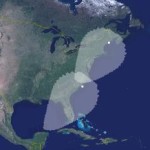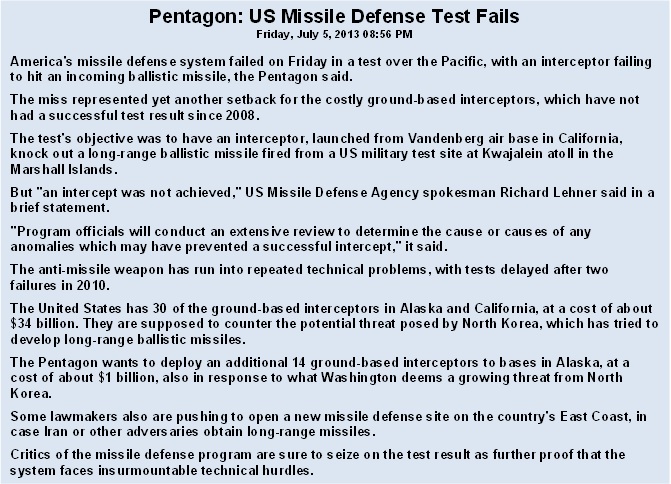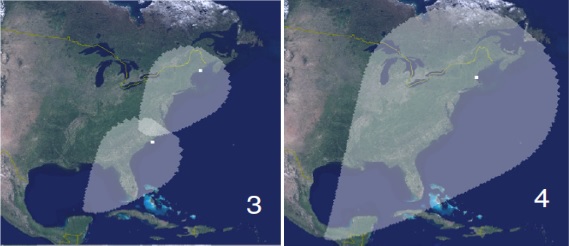Amb. Henry F. Cooper, Chairman . . . Lt. Gen. Daniel Graham, Founder
High Frontier . . Building Truly Effective Defenses . . Reagan’s Vision Lives!
E-Mail Message 130708
Go Navy . . . Be All You Can Be!
By Ambassador Henry F. Cooper
July 8, 2013
Given last Friday’s Ground Based Interceptor test failure and while that system is being improved, it is now even more important to assure that the Navy’s Aegis BMD system is made fully capable to defend the American homeland against long range intercontinental ballistic missile (ICBM) attack. It can rapidly provide a relatively inexpensive back-up capability—and with relatively inexpensive improvements can become a major adjunct defense of Americans at home as well as our overseas troops, friends and allies.
. . . .
Consequences of Last Friday’s Test Failure.
Friday’s Ground Based Interceptor test failure was widely reported around the world, presumably released by the Pentagon because of virtually identical verbiage in many of the overseas articles, as follows:
As might be anticipated, the New York Times embellished its report in a negative tone, emphasizing early quotes from Philip E. Coyle, who once oversaw the Pentagon’s weapons-testing programs and is now with the Center for Arms Control. Mr. Coyle apparently released a statement saying, among other things, that the system “is something the U.S. military, and the American people, cannot depend upon.”
I would remind Mr. Coyle that, as once noted by then Defense Secretary Donald Rumsfeld, “You go to war with the army you have, not the one you want or wish to have at a later time.” And we could shortly be at war with parties who wish us ill, so it behooves us to find something positive to make of the current situation rather than simply “poor mouthing” it.
Surely Mr. Coyle well understands that, whatever their potential, the ground based interceptors in Alaska and California, have a 50-percent success test record, which would be better than nothing against intercontinental ballistic missiles (ICBMs) from North Korea or Iran. And since this threat is a serious concern, the administration’s decision to buy an additional 14 interceptors now could be even more prudent than when it was announced by Defense Secretary Hagel.
Even more of note, Mr. Coyle should well understand that the Aegis ballistic missile defense (BMD) system has a much better test record (26 successes out of 32 attempts for over an 80-percent success record, not shabby for development testing). During the Clinton administration as the Defense Department’s Operational Test and Evaluation Chief, he applauded early Aegis BMD test successes and the fact that all Navy testing—from day one—has been carried out by operational crews. And if he has stayed up to date, he knows that the existing Standard Missile-3 (SM-3) has an inherent capability of intercepting ICBMs.
Inherent Aegis BMD Capability to Intercept ICBMs.
Not only has the SM-3 demonstrated this inherent capability by shooting down a dying satellite (in outer space traveling faster than an ICBM) to protect city dwellers from the toxic fuel that might have fallen on them. And in 2011, it was used to shoot down an intermediate-range test missile such as that used in last Friday’s test of the ground-based interceptor system. The currently most advanced SM-3 interceptor, the Block IB, is now being deployed and has had three successful intercepts in its last three attempts, beginning in 2012.
That these currently operational interceptors have an inherent anti-ICBM capability has been trumpeted to all who would listen by VADM J.D. Williams and myself for over a dozen years, while not receiving much interest from the “powers that be.” Perhaps the current situation offers an opportunity for those concerned about the effectiveness of our currently deployed homeland defense to reconsider our claims, most recently elaborated by Admiral Williams in our June 25th Independent Working Group (IWG) meeting on Capitol Hill. While I’d recommend your viewing the entire conference, see about 13:40 minutes into the video of that meeting for J.D.’s brief presentation.
The following two charts were used by VADM Williams. On the left, the shading illustrates the defense footprint for the current Block IA and IB interceptors on Aegis ships operating near our coasts, against Iranian ICBMs coming from the North—provided there are also two radars of the type currently deployed with our TMD systems: one in Maine and one on Camp Lejeune, NC. If these radars were funded and deployed, two Aegis ships near our East Coast could shoot down Iranian ICBMs aimed at our Eastern Seaboard, for which our Alaska-based ground based interceptors provide limited coverage.
The right chart illustrates the improvement that should be provided by the faster Block IIA interceptor, currently planned and funded at least for deployment in Poland by 2017 and potentially aboard our Aegis BMD ships at sea. A single Aegis BMD ship operating along the east coast, supported by a single radar in Maine, could then defend most of the United States east of the Mississippi, against ICBMs approaching from over the North Pole. Hmmmmm. Could this plan, to provide an operational capability by 2017, be accelerated?
A Long Standing, but Not Fully Funded Plan for Improvement.
These Navy BMD capabilities—and others—have long been understood—at least by J.D. and me—and openly advocated for well over a dozen years. For example, an Inside Missile Defense article we wrote in 2000 advocated the possible ascent-phase capability of Aegis BMD ships in the Sea of Japan against North Korean ICBMs. This inherent capability for higher velocity SM-3 interceptors is still unrealized—and an important potential capability that we should be pursuing, especially as the Block IIA comes on line, hopefully before 2017. This article also noted that, with aid from forward based X-band radars, our Aegis BMD ships would have the inherent capability to intercept North Korean ICBMs in their late mid-course stage, coming over the North Pole, as J.D.’s June 25. 2013 briefing once again stated—thirteen years later.
If these inherent capabilities are so clear to us, one has to wonder why they have not been adopted by the powers that be—indeed why do some still resist developing what seems so obviously achievable to us? I’d offer that the culprit is the antiballistic missile (ABM) Treaty that restricted the nation’s capabilities—and also our collective thinking for thirty years. Even after President Bush withdrew from the Treaty in 2002, the legacy of such stifled thinking has remained. Consider Aegis BMD as an interesting case history—and there are others we will share in the future.
The Retarding Legacy of the ABM Treaty.
J.D. and I began the Navy BMD programs in 1991 during my watch as director of the Strategic Defense Initiative (SDI) and while he was Director of Naval Warfare—and we have sought to get the powers that be to let Navy BMD achieve its full potential ever since. Initially this was politically difficult because we had to “undersell” the inherent Aegis capability to defend the U.S. homeland, because the ABM Treaty banned even the development and testing of sea-based interceptor systems if they provided a homeland defense. Thus, Aegis BMD was initiated as a Theater Missile Defense (TMD) program and its development was stunted from the outset.
While the Aegis BMD program has always enjoyed bipartisan Capitol Hill support, the administrations of both parties have restricted its growth.
During the Clinton administration, the program that I left in place in 1993 was modified in important ways—including those that slowed the interceptor burnout velocity causing a reduction in the defense coverage of the SM-3 to something greater than the left chart above, but less than the chart on the right—and substantially larger than other TMD systems. Near the end of the Clinton administration, there was an initiative to build a larger diameter interceptor to make up for this loss in burnout velocity, but that approach would have required a major infrastructure overhaul for our Aegis Cruisers and Destroyers—and, in my opinion, would have led to the death of the program.
Thankfully, our Japanese allies came to the rescue—with money to help and an insistence upon a design compatible with the existing infrastructure—restricting SM-3 development to a 21-inch diameter interceptor that fits within the widely deployed (on about 80 Aegis ships around the world) Vertical Launch System (VLS). Frankly, without the active support and funding from Japan, I believe Aegis BMD might have died in the cradle—but that’s a story for another day.
In the late 1990s, Congressional Aegis supporters, watching this stunting of Aegis BMD seemingly to remain consistent with the ABM Treaty, directed the administration to prepare a Report to Congress evaluating the potential to defend against ICBMs by using improving Aegis BMD system. Near the end of the Clinton years, that report, drafted by the Navy, finally made it through the Pentagon’s policy review—but in a dumbed-down form that left out important advantages, proposed by the Navy to be derived from lightweight Brilliant Pebbles technology.
The Clinton administration, as is well known, was committed to the ABM Treaty as the “cornerstone of strategic stability” and to the Mutual Assured Destruction (MAD) theology for deterring essentially all potential adversaries. They wanted no development that might undermine the commitment to the ABM Treaty.
Furthermore, any tie—even an implicit one—to Brilliant Pebbles was anathema during the Clinton administration, as demonstrated when the President used his fleeting “Line Item Veto” power in 1997 to veto funding for a deep space experiment as a follow-on to the award winning Clementine program (discussed further below) that earlier had space-qualified technology representing the complete sensor suite proposed for Brilliant Pebbles. His spokesman to the Press indicated the veto was because of concerns that follow-on Clementine-2 mission to a deep space asteroid, widely favored by the science community, was not permitted under by the ABM Treaty.
Still Continuing Legacy of ABM Treaty-related Retardation.
In any case, the Congressionally-directed Report to Congress was not submitted during the remaining Clinton administration—and the early Bush-43 administration did not re-examine the issue, a great disappointment to some of us. Those Bush-43 powers that be, for whatever reason, while contemplating the most welcome end of the ABM Treaty but not rectifying its prior constraints on Aegis BMD as a homeland defense capability, simply sent the Clinton report to the Hill. There was no apparent examination of Navy inputs that offered much more capability via higher velocity SM-3 interceptors because of the lighter weight and more capable kill vehicles derived from the Brilliant Pebbles technology.
Even worse news was that the Bush-43 Pentagon abandoned the residual Brilliant Pebbles team pursuing this lightweight technology. That team had survived even the Clinton years with the help of Congress, but when Bush-43 abandoned them—and the Republican led congress bowed to the Administration’s decisions, essentially all knowledge of the Brilliant Pebbles advances and applicability to other systems essentially vanished. Meanwhile, others—including the Chinese—have pursued these interests, while we have mostly marked time.
Back to the Future?
But some of us still remember and could, with needed support, reproduce the benefits of that technology—which in fact now should be several generations more advanced—to help make Navy BMD all it can be; and happily so, without the inhibitions of the ABM Treaty.
At a minimum, this miniaturization would achieve a 25-percent increase in the burnout velocity of a VLS-compatible SM-3 IIA with the larger defense footprint on the right below, allowing a single Aegis ship near our East Coast to defend the entire continental United States. Perhaps even while in port at Norfolk, Virginia.
Furthermore, if the Brilliant Pebble sensor suite were replicated in its miniature form, this advanced kill vehicle would also offer a much improved capability to counter advanced offensive countermeasures. Our May 14th email previously discussed how a version of these sensors was space-qualified on the widely acclaimed 1994 Clementine mission that received awards from NASA and the National Academy of Sciences for returning to the Moon for the first time in 25 years, mapping its surface in 13 spectral bands, and discovering water at the lunar South Pole, as confirmed in subsequent NASA missions.
A Recommendation for the Upcoming Report to Congress.
A good place to begin such a revival of lightweight technology would be to re-examine the over twenty-year-old Navy input in the latter days of the Clinton administration for the Report to Congress on how Navy BMD could support U.S. Homeland Defense. A challenge could be to locate that still pertinent Navy input.
In particular, the Navy’s recommendations of 15 years ago should be considered in the Pentagon study proposed by the Senate National Authorization Act, as reported in our June 28 email message. It directs the Secretary of Defense to provide a report on future options for defending the U.S. homeland, including:
- An assessment of the Ballistic missile threat from North Korea and Iran through 2022 and the effectiveness of our current and planned Ballistic Missile Defense (BMD) systems against that threat, including improvements that could result from additional ground based interceptors and sensors, additional ground based BMD sites, enhancements in operations effectiveness, and most notably:
- “[T]he potential for future enhancement and deployment of the[Navy’s] Standard Missile-3 Block IIA interceptor to augment United States homeland ballistic missile defense; missile defense options to defend the United States homeland against ballistic missiles that could be launched from vessels on the seas around the United States, including the Gulf of Mexico, or other ballistic missile threats that could approach the United States from the south, should such a threat arise in the future;” and
- “[A]ny other options the Secretary considers appropriate.”
While conducting a comprehensive examination of how best to defend the U.S. homeland from ballistic missile attack, Defense Secretary Hagel should take this important opportunity to set the above-discussed matters straight, and return to an agenda that intends, truly, to make Aegis BMD all it can be! Go Navy!
High Frontier Plans.
We at High Frontier will continue to inform the powers that be of existential threats to the American people—as we have discussed in our emails for many months—and to urge them to “provide for the common defense” as charged by the Constitution they are sworn to uphold. Hopefully, key federal authorities and members of congress will soon begin to deal more effectively with this existential threat, as we discussed on June 28th.
Dealing with this threat includes countering ICBMs that approach the U.S. over the North Pole, and Aegis BMD can play a critical role as discussed above. Aegis BMD can also counter threats from the south, including short range missiles launched from vessels in the Gulf of Mexico and from nuclear armed satellites that approach the U.S. from over the South Pole, as discussed in recent email messages.
We will also be taking the message to grass roots America. Our local and state authorities need to understand these issues and what they might do if their federal representatives continue to fail “to provide for the common defense.”
And what can you do?
Join us at High Frontier in seeking to alert the public and your local and state authorities to the existential threats posed by both man-made and natural EMP events—and what can be done about these threats.
We can use your help in spreading this information to the grass roots and to encourage all “powers that be” to provide for the common defense as they are sworn to do. Will you do your part?
Begin by passing this message to your friends and suggest they visit our webpage, www.highfrontier.org for more information. Also, please encourage your sphere of influence to sign up for our weekly e-newsletter!
Please click here to read Past Weekly Updates!
Please click here to read past Flash Messages!
Please help High Frontier continue this important and timely work!
Be sure to follow us on our Social Sites!
If you found this letter via our Social Sites, and you would like to subscribe, click below!








